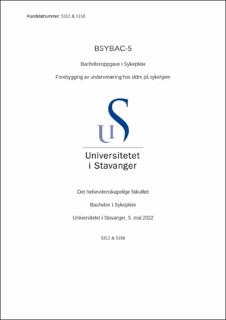| dc.contributor.advisor | Kleppa, Ragna | |
| dc.contributor.author | Gjerde, Karoline | |
| dc.contributor.author | Gjertsen, Camille | |
| dc.date.accessioned | 2022-07-08T15:52:37Z | |
| dc.date.available | 2022-07-08T15:52:37Z | |
| dc.date.issued | 2022 | |
| dc.identifier | no.uis:inspera:110142954:34673946 | |
| dc.identifier.uri | https://hdl.handle.net/11250/3003980 | |
| dc.description.abstract | Bakgrunn: Underernæring er et utbredt problem blant eldre på sykehjem, hvor inntaket av energi og/eller essensielle næringsstoffer ikke dekker vedkommende sitt behov. Dette kan føre til alvorlige konsekvenser. Det er ikke alltid synlig at en person i ernæringsmessig risiko, noe som gjør det spesielt viktig kunne kartlegge ernæringsstatus for å fange opp risiko tidlig i forløpet. Det er nødvendig med økt kompetanse og fokus rundt hvordan sykepleiere kan bidra til å forebygge underernæring blant eldre på sykehjem.
Hensikt: Hensikten med bacheloroppgaven er å belyse hvordan sykepleiere best kan kartlegge ernæringsstatus hos eldre på sykehjem. Videre ønsker vi å undersøke tidlige tiltak for å forebygge underernæring.
Metode: I oppgaven har vi brukt integrativ litteraturoversikt til å analysere tre kvantitative og en kvalitativ artikkel. De valgte artiklene skal ved hjelp av relevant teori, egne erfaringer og refleksjoner danne konklusjonen for denne oppgaven.
Resultater: Funnene viser at sykepleiere bør benytte seg av kartleggingsverktøy som viser sammenheng mellom ulike data. Dette for å få en forståelse for faktorer som har innvirkning på ernæringsstatusen. Både ernæringsjournalen og Mini Nutritional Assessment (MNA) viser seg å være godt egnet kartleggingsverktøy til bruk på sykehjem, men dette bør sees i sammenheng med beboeren sin totale livssituasjon og sykdomsbakgrunn. Tidlige tiltak som innebærer å skape god atmosfære og tilpasning av måltidet viser seg å ha godt effekt på måltidsglede og fører til økt matinntak hos beboere på sykehjem. | |
| dc.description.abstract | Background: Malnutrition is a widespread problem among the elderly in nursing homes, where the intake of
energy and/or essential nutrients do not meet the person's needs. This can lead to serious consequences. It is not always visible that a person is at nutritional risk, which makes it especially important to be able to assess nutritional status in order to capture risk early in the process. There is a need for increased competence and focus on how nurses can contribute to preventing malnutrition among the elderly in nursing homes.
Purpose: The purpose of the bachelor thesis is to shed light on how nurses can assess the nutritional status of the elderly in nursing homes in the best way. Furthermore, we want to investigate early actions to prevent malnutrition.
Method: In the thesis we have used an integrative literature review to analyze three quantitative and
one qualitative article. The selected articles will, with the help of relevant theory, our own experiences and reflections, form the conclusion of this thesis.
Results: The findings show that nurses should use screening tools that show connections between different data. This is to gain an understanding of factors that have an impact on nutritional status. Both the Nutritional Journal ("Ernæringsjournalen") and the Mini Nutritional Assessment (MNA) proves to be well-suited screening tools to use in nursing homes, but this should be seen in connection with resident's overall life situation and disease background. Early actions that invlove creating a good atmosphere and meal adaption prove to have a good effect on meal enjoyment and leads to increased food intake among residents of nursing homes. | |
| dc.language | nob | |
| dc.publisher | uis | |
| dc.title | Forebygging av underernæring hos eldre på sykehjem | |
| dc.type | Bachelor thesis | |
